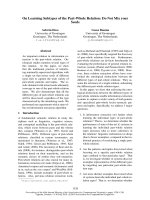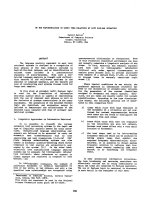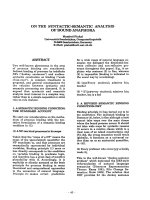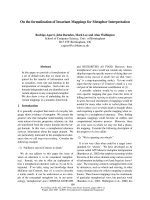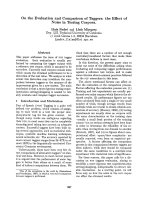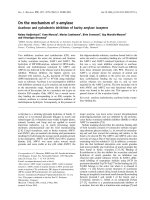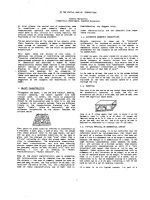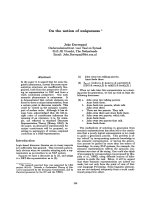Báo cáo sinh học: "On the relevance of three genetic models for the description of genetic variance in small populations undergoing selection" docx
Bạn đang xem bản rút gọn của tài liệu. Xem và tải ngay bản đầy đủ của tài liệu tại đây (653.17 KB, 12 trang )
Original
article
On
the
relevance
of
three
genetic
models
for
the
description
of
genetic
variance
in
small
populations
undergoing
selection
Florence
Fournet-Hanocq
Jean-Michel
Elsen
Station
d’amélioration
génétique
des
animaux,
Institut
national
de
la
recherche
agronomique,
31326
Castanet-Tolosan
cedex,
France
(Received
15
October
1996;
accepted
15
December
1997)
Abstract -
The
conservation
of
genetic
variability
is
recognized
as
a
necessary
objective
for
the
optimization
of
selection
schemes,
particularly
when
populations
are
small.
Numerous
models,
differing
by
the
genetic
model
they
rely
on,
are
available
to
better
understand
and
predict
the
evolution
of
genetic
variance
in
a
small
population
undergoing
selection.
This
paper
compares
three
genetic
models,
treated
either
analytically
or
with
Monte-Carlo
simulations,
first
in
order
to
validate
the
predictions
provided
by
a
’full-finite
model’
for
well-known
phenomena
(e.g.
the
effect
of
population
management
on
genetic
variability),
and
second,
to
evaluate
when
and
how
the
assumptions
made
in
the
two
analytical
models
induce
the
departure
from
the
third
model.
The
FFM
is
shown,
first,
to
be
in
close
agreement
with
the
Gaussian
theory
when
used
with
a
large
number
of
loci,
the
stochastic
approach
making
it
much
more
flexible
than
the
two
algebraic
models.
In
the
second
part
of
the
study,
the
infinitesimal
model
appears
to
be
more
robust
than
the
semi-
infinitesimal
one.
Major
sources
of
discrepancy
between
the
deterministic
models
and
the
FFM
are
identified,
notably
the
hypothesis
of
independence
between
loci,
and
then
the
infinite
number
of
loci
or
alleles
per
locus.
©
Inra/Elsevier,
Paris
modelling
/
genetic
variance
/
selection
/
small
population
*
Correspondence
and
reprints
Résumé -
De
l’intérêt
de
trois
modèles
génétiques
pour
la
description
de
la
variance
génétique
dans
les
petites
populations
sélectionnées.
La
conservation
de
la
variabilité
génétique
est
reconnue
comme
un
objectif
nécessaire
pour
l’optimisation
des
schémas
de
sélection,
notamment
pour
les
petites
populations.
De
nombreux
modèles,
différant
par
les
hypothèses
de déterminisme
génétique
sur
lesquels
ils
reposent,
sont
disponibles
pour
une
meilleure
compréhension
et
une
meilleure
prédiction
de
l’évolution
de
la
variabilité
génétique
dans
une
petite
population
soumise
à
sélection.
Cet
article
compare
trois
modèles
génétiques
différents,
traités
soit
par
la
voie
analytique
soit
par
des
simulations
Monte-
Carlo,
d’une
part
pour
valider
les
prédictions
fournies
par
un
« modèle
fini
complet
»
pour
des
phénomènes
connus
(comme
l’influence
de
la
gestion
de
la
population
sur
la
variabilité
génétique),
d’autre
part
pour
évaluer
quand
et
comment
les
hypothèses
faites
dans
les
deux
modèles
analytiques
induisent
un
écart
avec
le
dernier
modèle.
Le
modèle
fini
complet
apparaît,
dans
un
premier
temps,
en
bon
accord
avec
la
théorie
gaussienne
quand
il
est
utilisé
avec
un
grand
nombre
de
locus,
l’approche stochastique
le
rendant de
plus
beaucoup
plus
souple
que
les
deux
modèles
algébriques.
Dans
la
seconde
partie
de
l’étude,
le
modèle
infinitésimal
apparaît
plus
robuste
que
le
modèle
semi-infinitésimal.
Des
sources
majeures
d’écart
entre
les
modèles
déterministes
et
le
modèle
fini
complet
sont
identifiées,
notamment
l’hypothèse
de
l’indépendance
entre
les
locus,
puis
le
nombre
infini
de
locus
et
d’allèles
par
locus.
©
Inra/Elsevier,
Paris
modélisation
/
variance
génétique
/
sélection
/
petite
population
1.
INTRODUCTION
Genetic
variability
is
necessary
to
provide
genetic
progress
through
selection
and
the
conservation
of
genetic
variability
is
of
increasing
concern
in
the
optimization
of
selection
schemes,
particularly
when
selected
populations
are
small.
Numerous
experiments
[1,
6]
have
shown
a
decrease
in
genetic
variability
over
time,
due
to
genetic
drift
and
selection,
until
the
exhaustion
of
variance
in
many
cases.
Therefore,
thorough
knowledge
of
the
evolution
of
genetic
variance
in
relation
to
these
two
phenomena
is
important
when
constructing
optimal
selection
schemes.
Several
kinds
of
models
are
available
to
describe
the
evolution
of
genetic
variability,
depending
on
the
hypotheses
used
concerning
genetic
determinism.
Analytical
models,
whose
properties
often
rely
on
the
hypothesis
of
normality,
provide
a
quite
simple
formalization
of
the
phenomena
acting
on
genetic
variance.
Monte-Carlo
simulations
allow
a
more
detailed
and
complex
description
of
polygenic
inheritance.
This
paper
aims
to
compare
the
predictions
of
genetic
variability
in
a
small
population
undergoing
long-term
selection
provided
by
three
different
genetic
models,
two
of
them
treated
analytically
and
the
last
with
Monte-Carlo
simulations.
This
comparison
concerns
essentially
their
sensitivity
to
the
characteristics
of
the
genome.
The
genetic
models
underlying
the
Monte-Carlo
simulations
and
the
two
analytical
models
are
presented
first.
The
predictions
provided
by
the
three
models
will
then
be
compared
first
to
validate
the
genetic
model
used
in
the
MC
simulation
when
it
approaches
the
infinitesimal
hypothesis,
and
secondly
to
determine
when
the
analytical
models
depart
from
the
’full-finite
model’,
used
here
as
reference.
2.
DESCRIPTION
OF
THE
MODELS
Three
genetic
models
are
presented,
two
of
them
being
treated
analytically
and
the
last
with
Monte-Carlo
simulations.
The
Monte-Carlo
model
will
be
developed
first
as
the
most
complete
situation,
where
the
effects
of
genetic
drift
and
selection
are
not
algebraically
formalized
but
implicitly
accounted
for
in
the
simulation.
The
analytical
models
of
Verrier
et
al.
[14]
and
Chevalet
[3]
will
then
be
described,
each
corresponding
to
a
different
choice
of
hypotheses
for
the
algebraic
formalization
of
the
phenomena
acting
on
variance.
2.1.
The
’full-finite
model’
(or
FFM)
The
genetic
model
underlying
the
simulation
is
based
on
the
assumption
that
a
selected
trait
is
controlled
by
a
finite
number
of
linked
genes
individually
identified,
located
on
chromosomes,
with
a
finite
number
of
alleles
per
locus.
This
model
is
then
called
the
’full-finite
model’
or
FFM.
Individual
genotypes
are
generated
according
to
the
number
of
loci,
alleles
per
locus,
loci
per
chromosome,
recombination
rates
and
relative
effects
of
the
loci
on
the
selected
trait.
For
a
given
individual,
an
environmental
value
(assumed
to
be
normally
distributed)
is
added
to
its
generated
genotype,
giving
its
phenotypic
value.
A
within-generation
mass
selection
is
based
on
these
phenotypes.
Selected
breeding
individuals
are
randomly
mated
and
produce
a
new
generation.
This
is
performed
through
the
simulation
of
meiosis
and
pairing
of
gametes.
Generations
are
assumed
to be
discrete.
The
simulation
algorithm,
initiated
by
Hospital
[8]
and
developed
by
Fournet
et
al.
[7],
uses
the
Monte-Carlo
principle
and
provides
the
mean
values
and
standard
deviations
for
genetic
mean
and
variance
over
time.
2.2.
Analytical
models
The
first
model
presented,
established
by
Verrier
et
al.
[14],
relies
on
the
hypothesis
that
the
selected
trait
is
controlled
by
an
infinite
number
of
independent
loci,
with
identical
and
small
effects.
It
will
then
be
called
in
the
following
’infinitesimal
model’
or
IM.
The
computation
of
the
inbreeding
coefficient
in
this
model
accounts
for
the
effect
of
selection
on
family
structure
(for
more
details,
see
[14]).
The
second
model,
developed
by
Chevalet
[3]
for
a
monoecious
population
of
N
individuals,
assumes
a
finite
number
of
unlinked
loci
L
with
an
infinite
number
of
alleles
per
locus,
and
will
be
called
the
’semi-finite’
model
or
SFM.
The
joint
distribution
of
the
gene
effects
is
then
assumed
to
be
multivariate
normal.
Derivations
of
the
variances
of
gene
effects
and
covariances
between
gene
effects
under
selection
lead
to
the
prediction
of
the
joint
evolutions
of
genetic
and
genic
variances
by
two
recurrence
equations.
The
number
N
of
individuals
has
been
replaced
here
by
the
effective
size
of
population
Ne,
derived
from
the
Latter-
Hill
equation
[11],
with
a
Poisson
distribution
of
the
number
of
offspring
for
each
genealogical
path,
accounting
for
genetic
drift.
3.
CASES
STUDIED
A
polygenic-like
situation
with
an
infinite
number
of
alleles
per
locus
was
first
simulated
in
the
FFM,
to
check
if
the
evolution
of
genetic
variance
given
by
the
three
models
was
similar.
This
basic
system
was
defined
as
a
population
of
size
N
(with
as
many
males
as
females),
evaluated
on
their
own
performances
for
each
generation,
with,
respectively,
25
and
50
%
males
and
females
retained.
The
heritability
of
the
selected
trait
was
assumed
to
be
0.3.
A
thousand
independent
loci
with
500
alleles
per
locus
were
simulated
in
the
Monte-Carlo
model.
The
sensitivity
of
the
models
to
deviations
from
the
basic
situation
was
then
evaluated.
The
comparison
criterion
was
the
ratio
between
genetic
variances
at
generation
t and
generation
0
(RVI’l).
3.1.
Population
size
Different
sizes
of
candidate
population
N
(total
sizes
of
96,
192
and
480,
with
as
many
males
as
females
for
each
size)
were
tested.
3.2.
Parameters
of genetic
determinism
In
this
study
1 000,
100,
10
and
2
independent
loci
were
assumed
in
the
FFM
and
the
SFM.
This
comparison
of
sensitivity
to
the
number
of
loci
was
performed
assuming
that
all
loci
were
located
on
one
chromosome
in
the
FFM.
Here
100,
10
and
2
alleles
per
locus,
in
the
case
of
100
or
10
loci,
were
simulated
in
the
FFM
in
order
to
show
the
deviation
of
the
SFM
from
the
FFM
when
this
parameter
decreases.
The
recombination
rate
r
was
assumed
to
be
0.5,
0.1,
0.01
and
0.001,
in
the
case
of
1000,
100
and
10
multiallelic
loci
controlling
the
selected
trait,
in
order
to
check
the
effect
of
linkage
on
the
prediction
of
genetic
variance
over
time
in
the
FFM.
The
effect
of
linkage
was
not
studied
in
the
model
of
Chevalet,
as
assuming
ri! !
0.5
for
any
pair
of
loci
(i,j)
would
produce
as
many
equations
as
different
pairs
of
loci.
In
the
’full
finite’
model,
the
relative
contributions
of
the
loci
to
the
genetic
variance
of
the
selected
trait
were
assumed
to
be
identical
in
the
preceding
comparisons.
To
test
the
robustness
of
the
results
with
respect
to
this
assumption,
and
following
Lande
and
Thompson
(1990),
variances
were
assumed
to
follow
a
geometric
series,
with
the
lth
locus
contributing
V7l(l —a)a!B
where
the
constant
a
determines
the
relative
magnitude
of
the
contributions
of
each
locus.
This
constant
is
related
to
the
effective
number
of
loci
as:
Le
=
(1
+
a)/(1 -
a).
Simulations
were
performed
with
1 000
biallelic
loci,
with
effects
following
a
geometric
series
where
the
parameter
a
was
given
values
corresponding
to
2,
5,
10, 50
and
100
effective
loci.
The
resulting
evolutions
of
genetic
variability
were
compared
to
the
corresponding
curves
of
loci
with
identical
contributions.
Thirty
generations
of
selection
were
simulated.
A
hundred
simulations
were
performed
for
each
combination
of
factors.
With
as
many
simulations,
a
difference
just
higher
than
5
%
between
the
predictions
of
the
different
models
would
be
significant
(at
the
5
%
level).
A
10
%
difference
was
then
considered
as
significantly
larger.
4. RESULTS
The
predictions
provided
by
the
three
models
for
the
joint
effects
of
population
size
and
selection
intensity
on
the
evolution
of
genetic
variance
were
compared.
Figure
1 illustrates
the
case
of
intermediate
value
of
selection
intensity
(i.e.
25
%
of
males
selected),
as
the
trend
was
the
same
for
the
other
two
tested values
(50
%
and
6.25
%
of
males
selected).
It
can
be
pointed
out
that
the
three
models
provided
almost
the
same
evolution
of
genetic
variance,
whatever
the
population
size
and
selection
intensity.
As
expected
[4],
the
higher
the
selection
intensity,
the
greater
the
influence
of
the
population
size,
and
the
higher
the
decrease
in
genetic
variance.
This
comparison
of
the
predictions
given
by
analytical
and
stochastic
models
for
well-known
phenomena
allowed
validation
of
the
genetic
model
used
for
the
MC
simulations.
4.1.
Effect
of
number
of loci
Table
I
presents
the
values
of
RV[30]
provided
by
the
three
models
when
decreasing
the
number
of
loci
L
(with
multiallelic
loci
in
the
FFM).
RV
[30
]
in
the
IM
departed
by
more
than
10
%
from
the
FFM
prediction
for
studied
values
of
L
lower
than
250,
while
the
predictions
of
SFM
and
FFM
were
in
quite
good
agreement
for
more
than
50
loci.
Although
the
semi-infinitesimal
model
accounts
for
a
finite
number
of
loci,
its
sensitivity
to
this
parameter
is
quite
weak:
the
difference
between
IM
and
SFM
exceeds
10
%
only
when
the
number
of
loci
considered
in
the
SFM
is
lower
than
10.
This
behaviour
must
be
related
to
the
hypothesis
of
infinite
number
of
alleles
per
locus.
Results
of
FFM
presented
later,
where
the
effect
of
the
number
of
loci
decreases
when
increasing
the
number
of
alleles
per
locus,
are
consistent
with
this
observation.
Figure 2
illustrates
the
evolution
of
RV’
I
over
time
for
1 000,
100,
10
or
2
loci.
For
100
loci,
IM
and
SFM
depart
from
FFM
only
after
20
generations,
while
for
10
loci,
they
both
depart
from
FFM
as
early
as
generation
7
and
with
2
loci,
IM
and
SFM
depart
from
FFM
after
generations
3
and
6,
respectively.
The
additive
genetic
variance
in
FFM
decreased
dramatically
with
a
very
small
number
of
loci
(10
and
2).
This
result
was
of
course
expected
and
it
illustrates
the
strong
influence
of
the
infinitesimal
hypothesis
on
the
predictions.
However,
the
infinitesimal
model
remains
quite
robust
so
long
as
the
number
of loci
assumed
is
not
too
small.
4.2.
Effect
of
the
number
of
alleles
per
locus
Figure
3a,
b
indicates
a
loss
of
genetic
variance
in
the
FFM,
when
the
num-
ber
A
of
alleles
decreased,
higher
when
the
number
of
loci
was
smaller:
the
ge-
netic
variance
decreased
for
fewer
than
10
alleles
per
locus
for
L
=
100
and
100
alleles
per
locus
for
L
=
10.
A
combination
of
the
two
variables
indicating
the
amount
of
available
variability
influenced
the
behaviour
of
the
genetic
variance
over
time,
more
than
did
each
variable
alone:
at
a
given
generation,
1000
biallelic
loci
and
100
loci
with
50
alleles
per
locus
provided
the
same
RV’
I
(results
not
shown).
4.3.
Effect
of linkage
between
loci
The
decrease
in
genetic
variance
when
increasing
the
linkage
between
loci
was
higher
when
the
number
of
loci
was
lower.
For
1000
multiallelic
loci,
only
very
strong
linkage
(r
=
0.001)
gave
a
significant
decrease
in
the
predicted
RV[30]
in
the
FFM
(38
%
lower
than
for
r
=
0.5).
For
100
(figure
4)
or
10
multiallelic
loci,
no
difference
was
observed
between
the
absence
of
linkage
and
a
recombination
rate
of
0.1,
but
below
r
=
0.01,
stronger
linkage
led
to
a
higher
decrease
in
genetic
variance
in
the
early
generations
and
a
lower
asymptotic
plateau
in
the
latter
ones.
In
fact,
a
large
number
of
linked
loci
behave
as
a
small
number
of
independent
loci.
To
a
certain
extent,
the
genome
size
seemed
the
main
factor
acting
on
genetic
variance,
in
agreement
with
Robertson
[12]
who
showed
that
the
limit
in
genetic
response
for
a
given
recombination
rate
was
directly
linked
to
the
chromosome
length.
Nevertheless,
the
comparison
remained
limited
as
Robertson
inferred
a
general
description
of
the
selection
process
in
finite
populations
only
for
a
large
number
of
loci.
4.4.
Effect
of
inequality
between
loci
effects
Predictions
of
the
genetic
variance
for
1 000
biallelic
loci
whose
effects
followed
a
geometric
series,
with
varying
parameter
a
giving
a
number
Le
of
effective
loci,
and
predictions
for
L
=
Le
loci
with
identical
effects
are
compared
in
figure
5.
It
can
be
seen
that
the
predictions
for
L
=
x
loci
of
identical
effects
and
for
1 000
loci
of
differential
effects
giving
Le
=
x
effective
loci
were
very
close,
whatever
the
value
of x.
This
showed
that
even
1000
loci
could
not
be
considered
an
infinitesimal
genome,
if
the
hypothesis
of
differential
effects
of
the
loci
(a
few
loci
with
relatively
large
effects
and
many
others
with
small
effects)
is
true
[10].
5.
DISCUSSION
AND
CONCLUSION
The
first
part
aimed
to
investigate
the
validity
of
the
genetic
model
underlying
the
MC
simulations,
when
compared
to
analytical
models
corresponding
to
different
hypotheses
on
the
genetic
determinism.
The
first
result
to
be
pointed
out
was
that
the
three
models,
when
a
large
number
of
loci
were
assumed
for
the
’semi-finite’
and
’the
full-finite’
models,
were
in
close
agreement,
whatever
the
population
size
and
selection
intensity
assumed.
Moreover,
the
computation
of
the
effective
population
size
for
the
monoecious
model
of
Chevalet
seemed
to
be
quite
valid
as
it
provided
the
same
prediction
as
the
dioecious
models.
This
part
verified
that
under
the
hypothesis
of
a
very
large
number
of
independent
identical
loci,
the
oligogenic
model
and
the
Gaussian
theory
agree
closely.
These
first
results
validate
the
use
of
the
’full-finite’
model
in
infinitesimal
conditions,
as
its
predictions
seem
reliable
and
the
stochastic
approach
makes
it
much
more
flexible
than
the
other
two
models.
Furthermore,
the
stochastic
approach
intrinsically
takes
account
of
the
reduction
in
selection
intensity
as
compared
with
the
theory,
of
the
relationships
between
mates
and
inbreeding
induced
in
the
offspring
and
of
the
changing
variance
of
gene
effects
due
to
genetic
drift
and
faster
or
slower
fixation
of
alleles.
The
need
of
unknown
parameters
to
introduce
in
the
model
does
not
prevent
its
use,
as
the
other
two
models
also
make
assumptions
on
the
unknown
parameters
they
use.
And
the
increasing
knowledge
on
QTLs
implied
in
the
genetic
determinism
of
selected
traits
will
provide
elements
for
such
a
modelling.
In
the
second
part,
the
hypothesis
of
an
infinite
number
of
loci
controlling
the
selected
trait
was
shown
to
be
very
important:
similar
prediction
of
RVI’
L
with
infinitesimal
and
’full-finite’
models
was
obtained
only
when
simulating
more
than
500
loci
in
the
FFM.
Under
this
value,
the
departure
of
the
Verrier
et
al.
[14]
model
from
the
FFM
was
substantial.
One
can
wonder
if
such
a
large
number
of
loci
(500
or
1000)
controlling
one
trait
is
realistic?
Tanksley
[13]
suggests
that
the
number
of
QTL
implicated
in
various
traits
for
a
large
set
of
animal
or
vegetable
species
should
vary
between
1
and
18.
But
famous
selection
experiments
on
maize
[5]
expressed
genetic
progress
over
76
generations,
suggesting
that
genetic
variability
is
infinite
according
to
the
infinitesimal
theory.
In
animal
breeding
also,
selection
experiments
have
been
based
on
this
theory
for
a
long
time
and
no
evidence
of
important
discrepancy
between
results
and
theory
has
been
found.
This
contradiction
strengthens
the
value
of
estimating
the
effective
number
of
QTL
controlling
a
trait.
It
also
points
out
the
lack
of
complexity
in
the
FFM
hypotheses:
adding
interactions
between
genes
or
mutations,
or
locating
the
genes
on
several
chromosomes,
might
be
more
realistic
and
informative.
Indeed,
recent
studies
[2,
9]
investigated
the contribution
of
mutations
as
a
source
of
new
genetic
variance
in
mice.
But,
in
our
study,
since
the
other
two
models
did
not
account
for
interactions
or
for
new
genetic
variance
arising
from
mutation,
this
hypothesis
was
excluded
in
this
version
of
FFM.
The
second
hypothesis
of
an
infinite
number
of
alleles
per
locus
may
explain
the
discrepancy
observed
between
the
’semi-finite’
and
the
’full-finite’
models
for
various
numbers
of
loci.
The
total
amount
of
available
genetic
variability,
i.e.
the
combination
between
the
numbers
of
loci
and
alleles
per
locus,
is
not
taken
into
account
in
the
same
way
in
the
two
models.
Is
an
infinite
number
of
alleles
per
locus
more
realistic
than
an
infinite
number
of
loci?
Mutations
might
lead
to
a
huge
number
of
very
close
allelic
forms,
whose
effects
are
normally
distributed;
on
the
contrary,
the
large
potential
variability
is
reduced
because
some
of
the
mutational
allelic
forms
are
not
functional,
and
different
alleles
give
exactly
the
same
phenotype.
In
the
end,
a
discrete
distribution
of
allelic
effects
is
possible.
In
this
case,
the
prediction
provided
by
the
’semi-finite’
model
holds
true
only
in
the
short
term,
with
a
very
slow
decrease
in
variance
after
the
first
generations
of
selection,
whereas
the
’full-finite’
model
shows
a
clear
tendency
to
a
rapid
fixation
of
available
alleles.
The
effect
of
linkage
was
also
studied
by
Hospital
[8].
Two
phases
can
be
observed
in
our
results
when
the
linkage
is
strong:
a
first
phase
with
a
rapid
decrease
in
genetic
variability
and
a
second
phase
of
slow
decrease
reaching
a
plateau.
Hospital
[8]
explained
this
phenomenon
by
a
weak
rearrangement
of
gametes
by
recombination.
Selection
first
sorts
the
most
favourable
combinations
in
the
initial
genetic
pool,
with
a
rapid
reduction
in
genetic
variability,
and
produces
hitch-hiking
phenomena:
unfavourable
genes
are
selected
jointly
with
favourables
ones
and
are
poorly
eliminated
because
of
the
low
recombination
rate
in
the
second
phase.
When
linkage
is
less
intense,
the
gametes
are
reorganized
by
recombination
over
a
longer
period
and
the
decrease
in
genetic
variance
is
more
regular.
This
part
of
the
study
demonstrates
a
major
source
of
possible
discrepancy
from
reality
when
using
the
two
analytical
models:
as
they
both
consider
independent
loci,
they
are
likely
to
overestimate
the
remaining
genetic
variance
over
time.
It
may
then
be
underlined
that
the
ability
to
consider
a
possible
linkage
between
loci
confers
a
greater
concern
to
the
genetic
model
in
the
FFM,
as
linkage
is
known
to
exist
between
loci
and
is
notably
an
essential
principle
for
QTL
detection.
Finally,
the
identical
effects
of
the
loci
appeared
to
be
a
strong
hypothesis.
Indeed,
following
Lande
and
Thompson
[10],
the
distribution
of
gene
effects
according
to
a
geometric
series
pointed
out
that
the
number
of
effective
loci
was
of
greater
concern
than
the
real
number
of
loci.
This
point
is
also
of
great
concern
in
this
study.
Indeed,
results
of
molecular
genetics
indicate,
for
most
of
the
quantitative
traits
under
study,
the
influence
of
a
mixed
heredity,
i.e.
a
small
number
of
genes
with
large
effects
and
a
large
number
of
genes
with
small
effects.
But
this
kind
of
genome
structure
is
not
easy
to
integrate
in
analytical
models.
The
approach
developed
by
Chevalet
[3]
accounts
for
differential
distribution
of
gene
effects,
by
joining
genes
with
variable
contributions
to
the
genetic
variance
of
the
trait
into
several
independent
clusters
of
genes
with
equal
contributions.
Moreover,
within
one
given
group
of
genes
in
this
model,
the
loci
may
be
closely
linked.
The
main
disadvantage
of
this
approach
is
the
overestimation
of
genetic
variance
after
the
first
generation,
probably
due
to
the
departure
of
the
gene
effects
from
Gaussian
distribution.
By
accounting
for
a
finite
number
of
loci
and
a
finite
number
of
alleles
per
locus,
the
’full-finite’
genetic
model
developed
in
this
paper,
with
a
stochastic
approach,
seems
to
be
an
easy
and
quite
consistent
way
for
studying
the
behaviour
of
genetic
mean
and
variance
in
a
situation
of
mixed
heredity.
REFERENCES
[1]
Al
Murrani
W.K.,
Roberts
R.C.,
Genetic
variation
in
a
line
of
mice
selected
to
its
limit
for
high
body
weight,
Anim.
Prod.
19
(1974)
273-289.
[2]
Caballero
A.,
Keightley
P.D.,
Hill
W.G.,
Accumulation
of
mutations
affecting
body
weight
in
inbred
mouse
lines,
Genet.
Res.
65
(1995)
145-149.
[3]
Chevalet
C.,
An
approximate
theory
of
selection
assuming
a
finite
number
of
quantitative
trait
loci,
Genet.
Sel.
Evol.
26
(1994)
379-400.
[4]
Crow
J.F.,
Kimura
M.,
An
Introduction
to
Population
Genetics
Theory,
Harper
and
Row,
New
York,
1970.
[5]
Dudley
J.W.,
Seventy-six
generations
of
selection
for
oil
and
protein
percentage
in
maize,
in:
Pollack
E.,
Kempthorne
0.,
Bailey
T.B.
Jr
(Eds.),
Proceedings
of
International
Conference
on
Quantitative
Genetics,
Iowa
State
Univ.
Press,
Ames,
1977,
pp.
459-473.
[6]
Falconer
D.S.,
Improvement
of
litter
size
in
a
strain
of
mice
at
a
selection
limit,
Genet.
Res.
12
(1971)
215-235.
[7]
Fournet
F.,
Hospital
F.,
Elsen
J.M.,
A
FORTRAN
program
to
simulate
the
evolution
of
genetic
variability
in
a
small
population,
Comput.
Applic.
Biosci.
11
(1995)
469-475.
[8]
Hospital
F.,
Effets
de
la
liaison
génique
et
des
effectifs
finis
sur
la
variability
des
caract6res
quantitatifs
sous
selection,
these
de
Doctorat,
Universite
Montpellier
II.
[9]
Keightley
P.D.,
Hill
W.G.,
Quantitative
genetic
variation
in
body
size
of
mice
from
new
mutations,
Genetics
131
(1992)
693-700.
[10]
Lande
R.,
Thompson
R.,
Efficiency
of
marker-assisted
selection
in
the
improvement
of
quantitative
traits,
Genetics
124
(1990)
743-756.
[11]
Ollivier
L.,
Le
calcul
de
1’effectif
génétique
des
populations
animales,
Ann.
Genet.
Sel.
Anim.
5
(1973)
363-368.
[12]
Robertson
A.,
A
theory
of
limits
in
artificial
selection
with
many
linked
loci,
in:
Kojima
K.
(Ed.),
Mathematical
Topics
in
Population
Genetics,
Springer-Verlag,
Berlin,
1970,
pp.
246-288.
[13]
Tanksley
S.D.,
Mapping
polygenes,
Annu.
Rev.
Genet.
27
(1993)
205-233.
[14]
Verrier
E.,
Colleau
J.J.,
Foulley
J.L.,
Predicting
cumulated
response
to
directional
selection
in
finite
panmictic
populations,
Theor.
Appl.
Genet.
79
(1990)
833-840.

